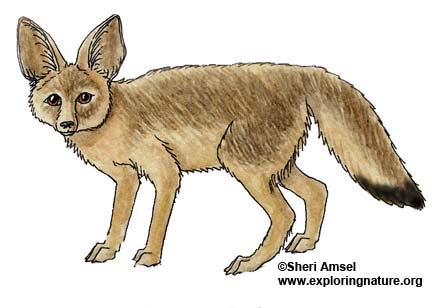

They are found in western North America and south into Mexico.
They live in open prairie, plains and desert areas.
They are one of the smallest foxes in North and South America. They are tan to rust colored, and lighter underneath. They have very large ears that help cool them. They do this at night when the air is cold and blood circulating through the ears is cooled by the night air. They have long legs and a bushy tail with a black tip, which, like all foxes, they carry straight out behind them when they travel.
They are active mostly at night when temperatures are cooler (nocturnal). They can run up to 25 mph (40 km/h).
They eat rabbits, hares, mice, small birds, lizards, insects, plants, fruit and dead animals.
They are hunted by coyotes, red fox, dogs, bobcats, and hawks.
Females are pregnant for 8 weeks (gestation) have up to 7 young.
They can live up to 6 years in the wild. They are listed as endangered.
Kingdom: Animalia
Phylum: Chordata
Subphylum: Vertebrata
Class: Mammalia
Order: Carnivora
Suborder: Caniformia
Family: Canidae
Genus: Vulpes
Species: Vulpes macrotis
When you research information you must cite the reference. Citing for websites is different from citing from books, magazines and periodicals. The style of citing shown here is from the MLA Style Citations (Modern Language Association).
When citing a WEBSITE the general format is as follows.
Author Last Name, First Name(s). "Title: Subtitle of Part of Web Page, if appropriate." Title: Subtitle: Section of Page if appropriate. Sponsoring/Publishing Agency, If Given. Additional significant descriptive information. Date of Electronic Publication or other Date, such as Last Updated. Day Month Year of access < URL >.
Amsel, Sheri. "Fox (Kit)" Exploring Nature Educational Resource ©2005-2024. December 13, 2024
< http://www.exploringnature.org/db/view/Fox-Kit >

